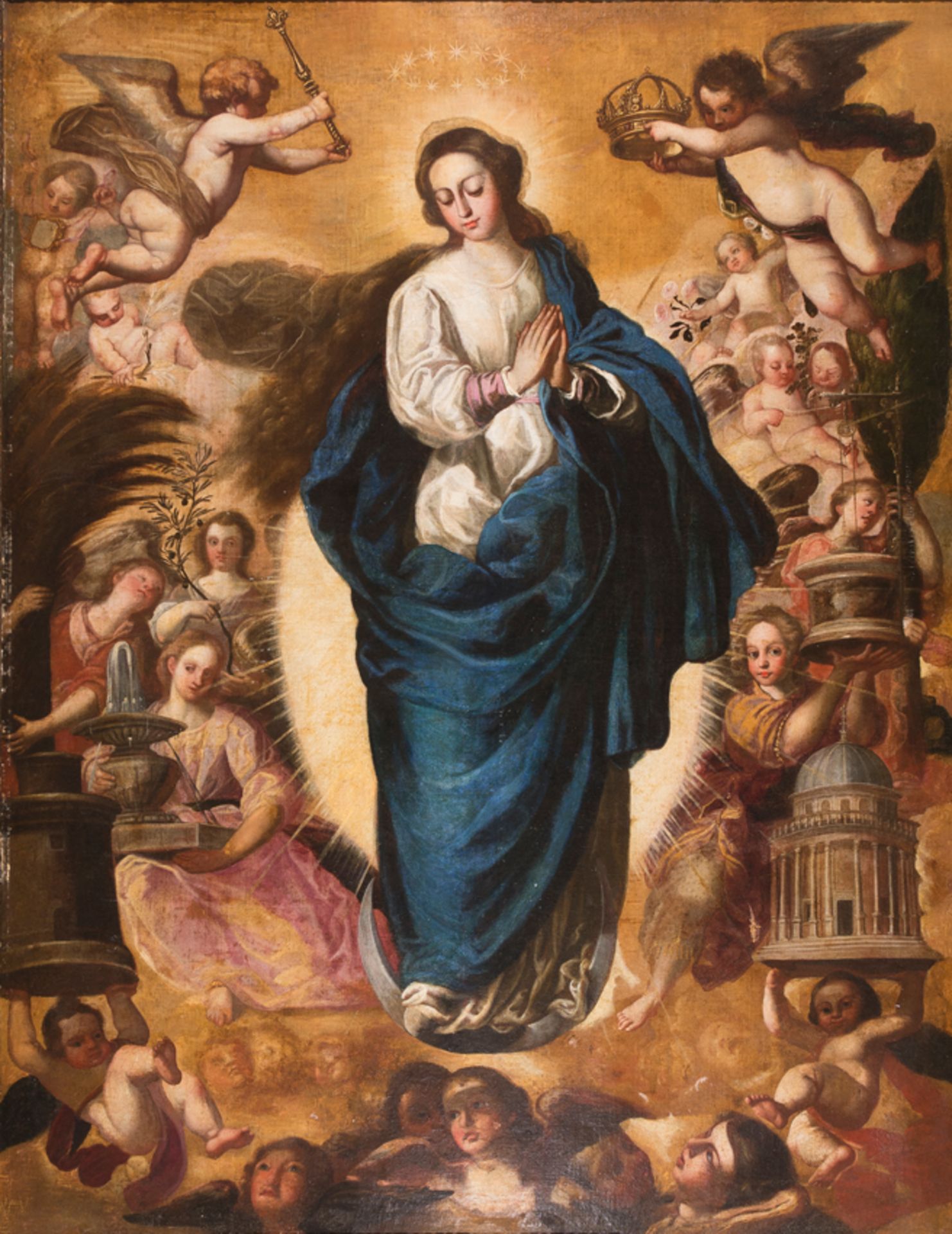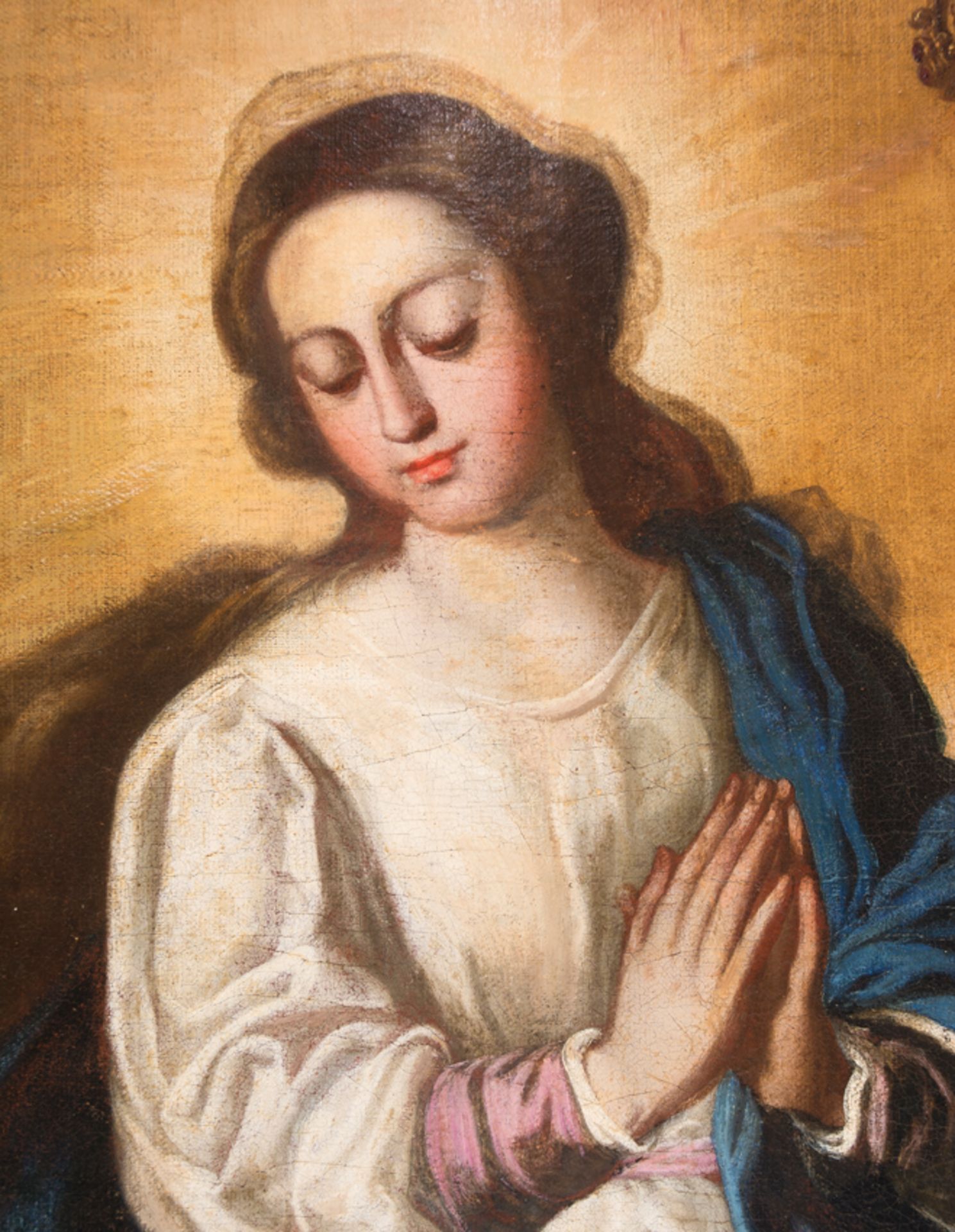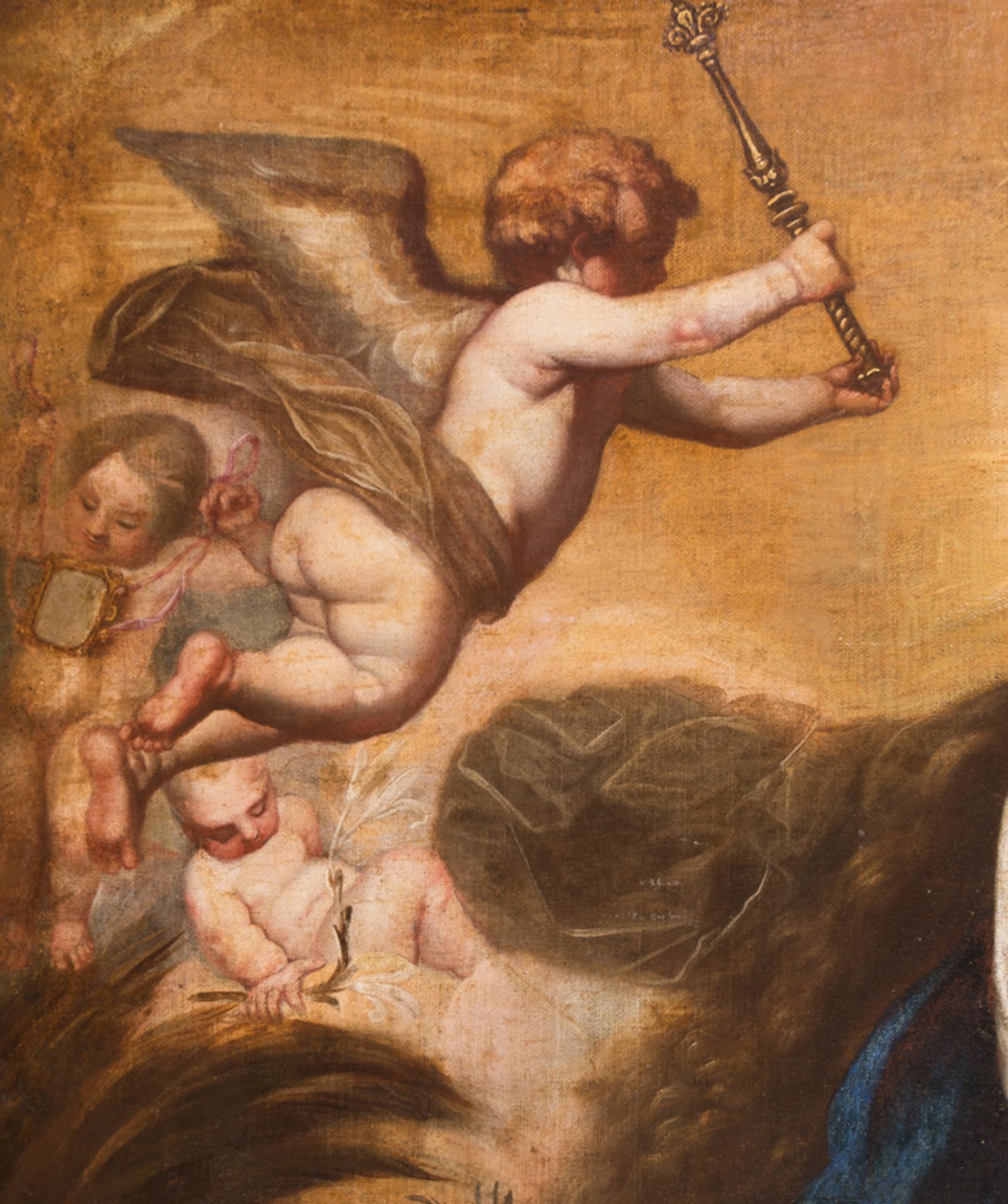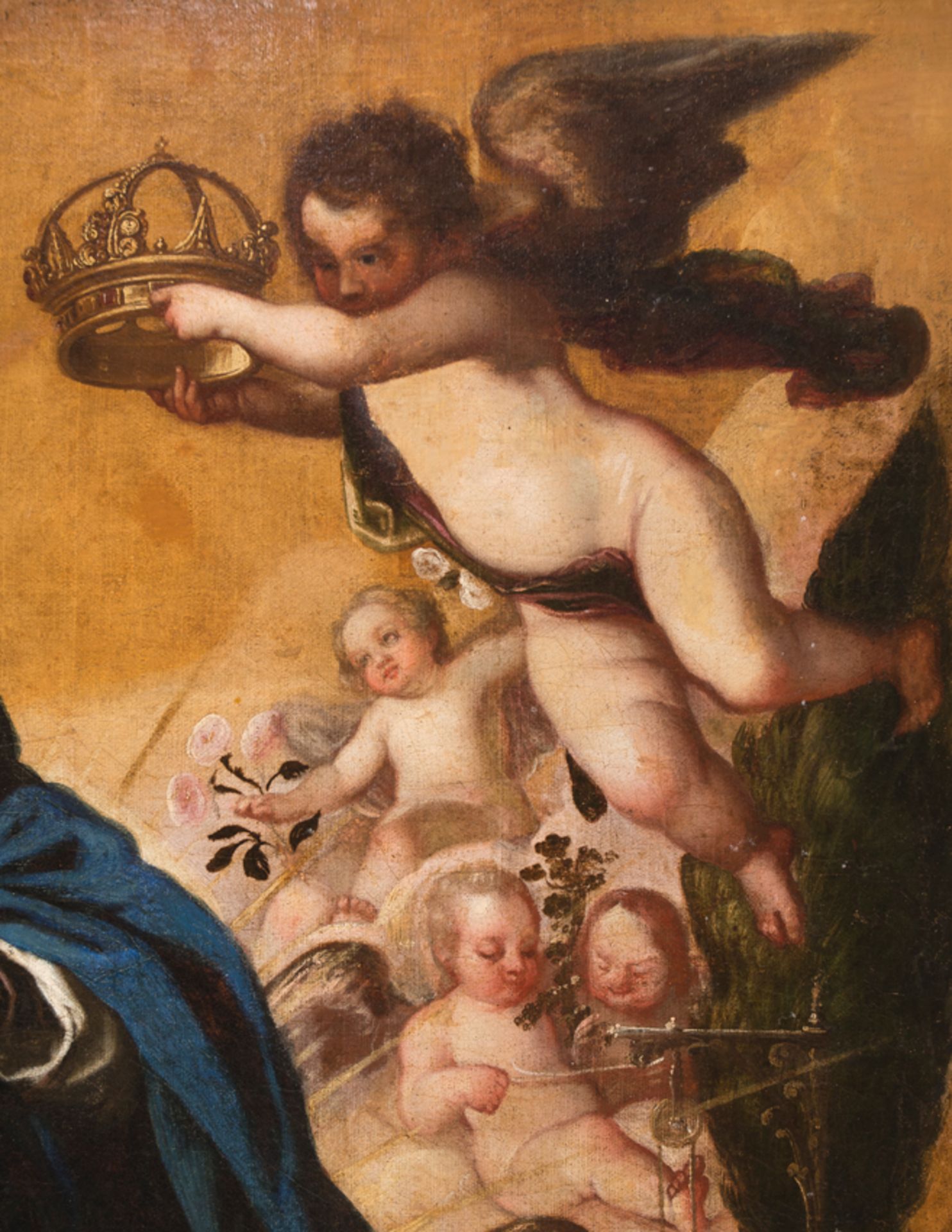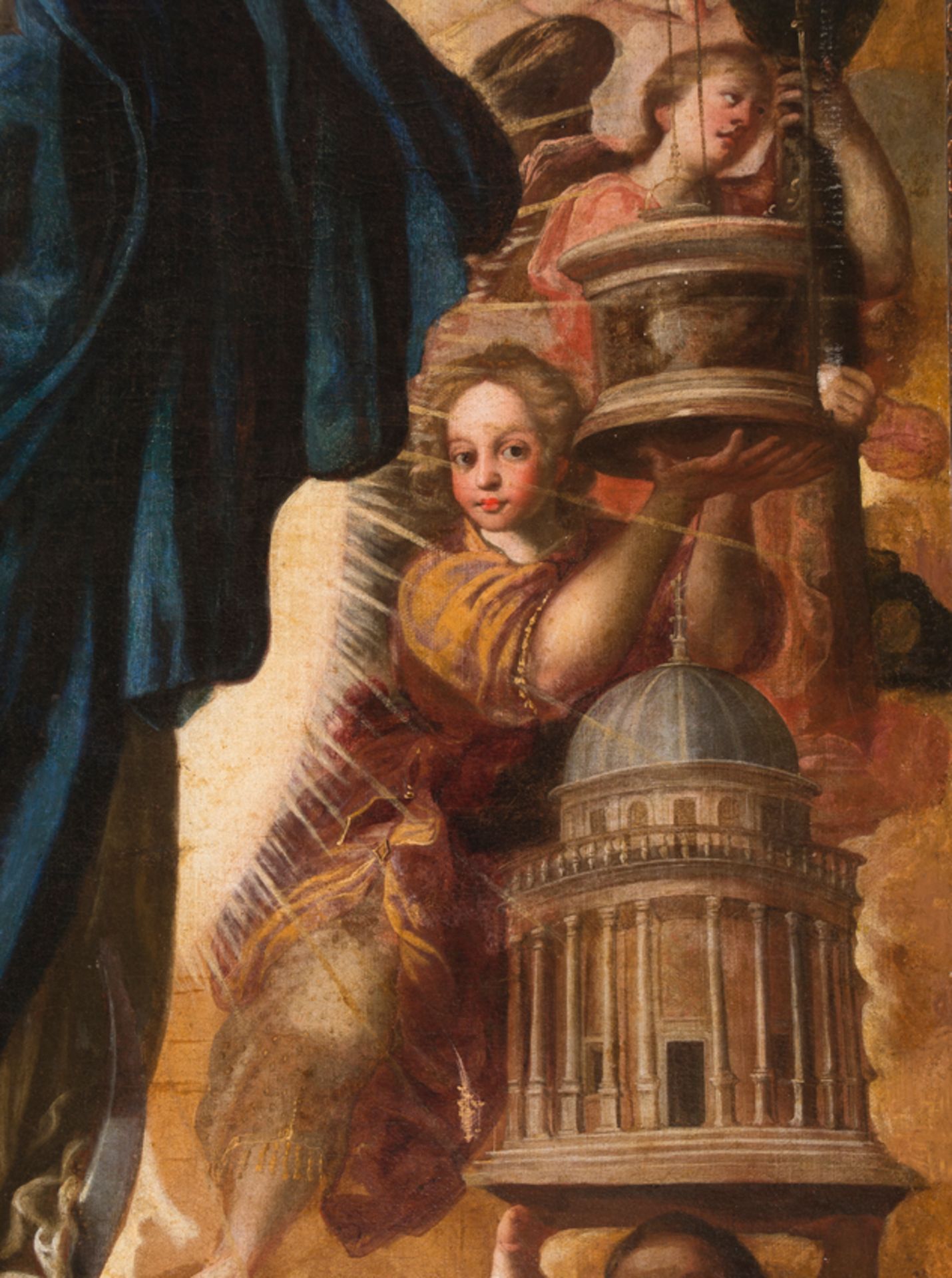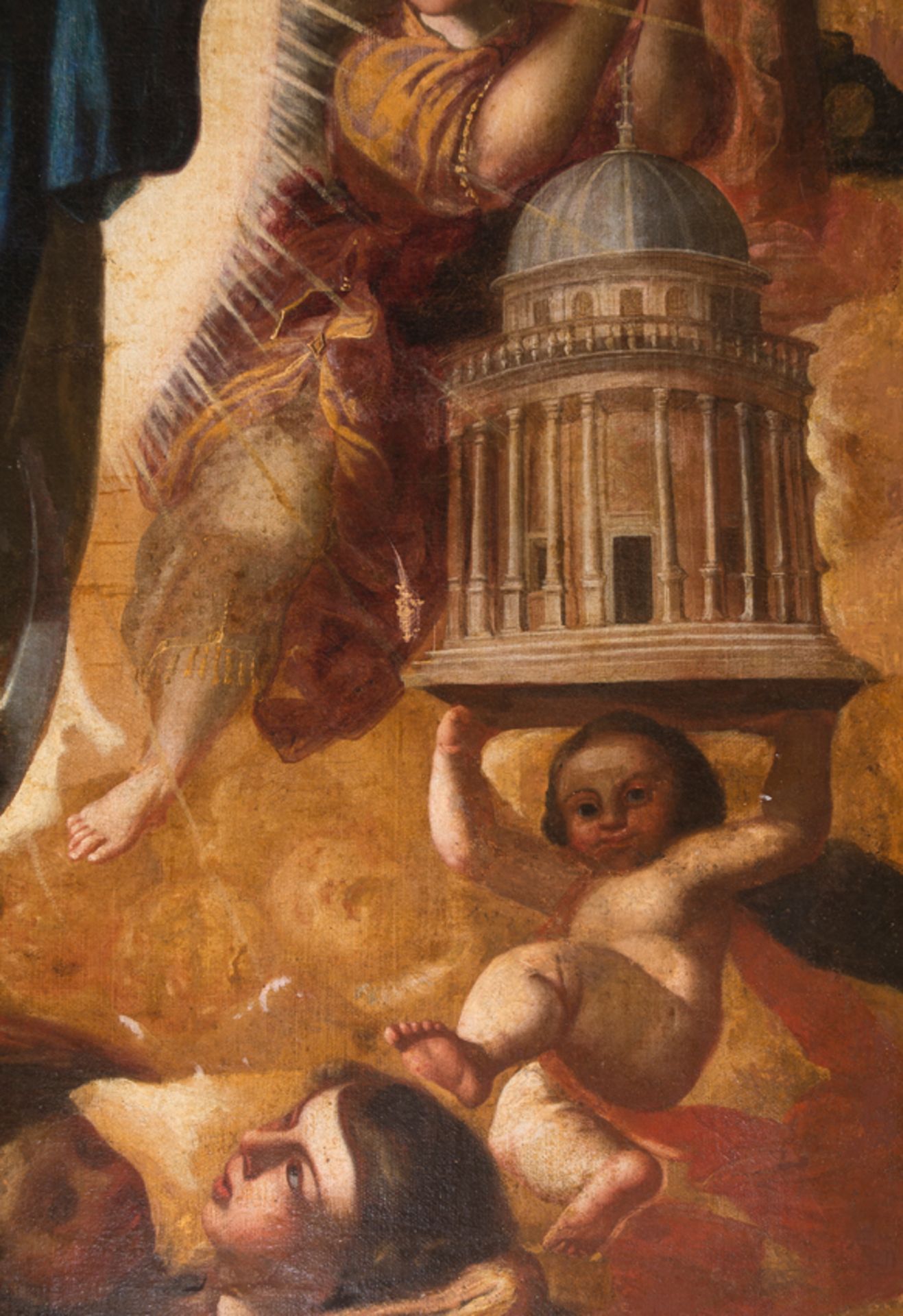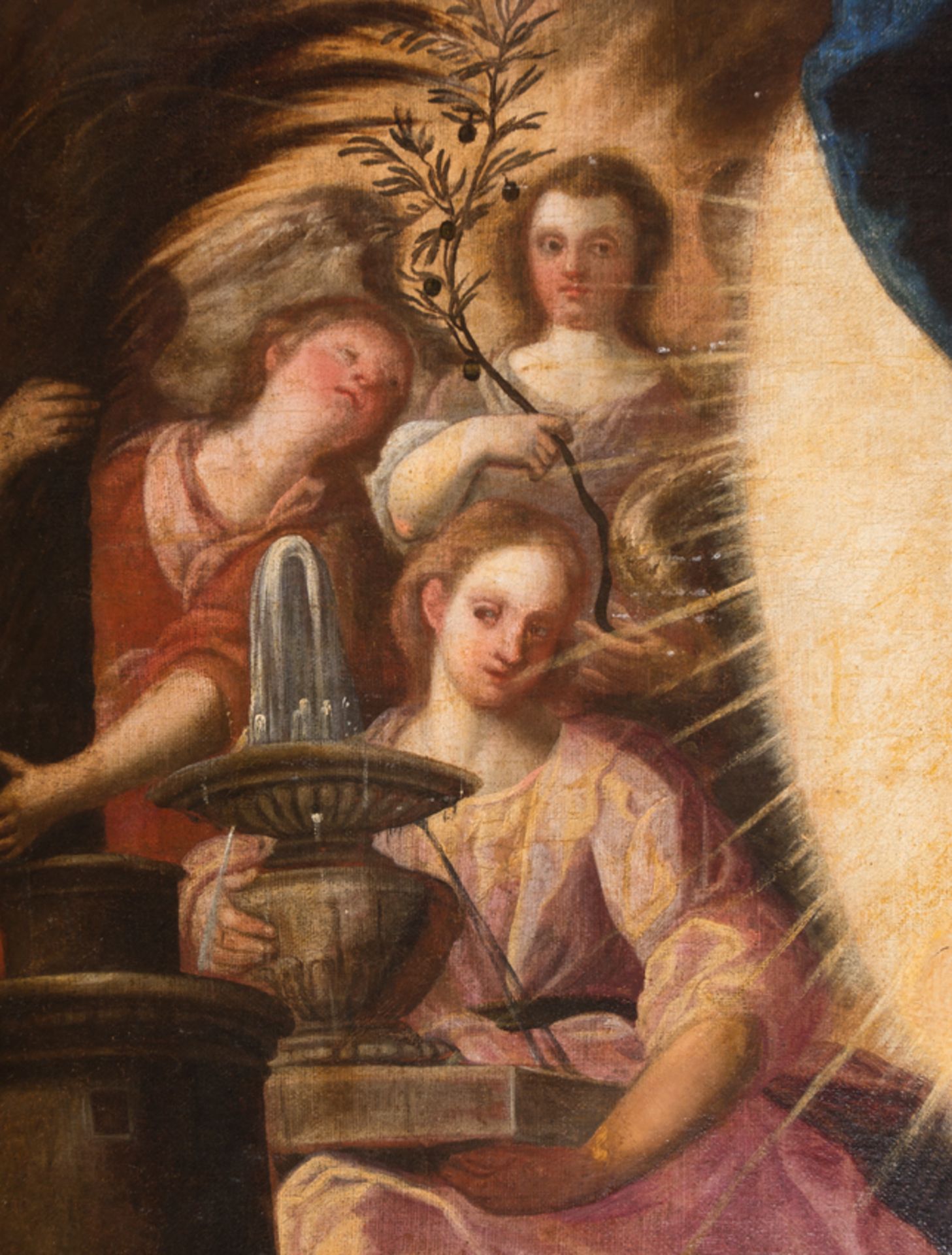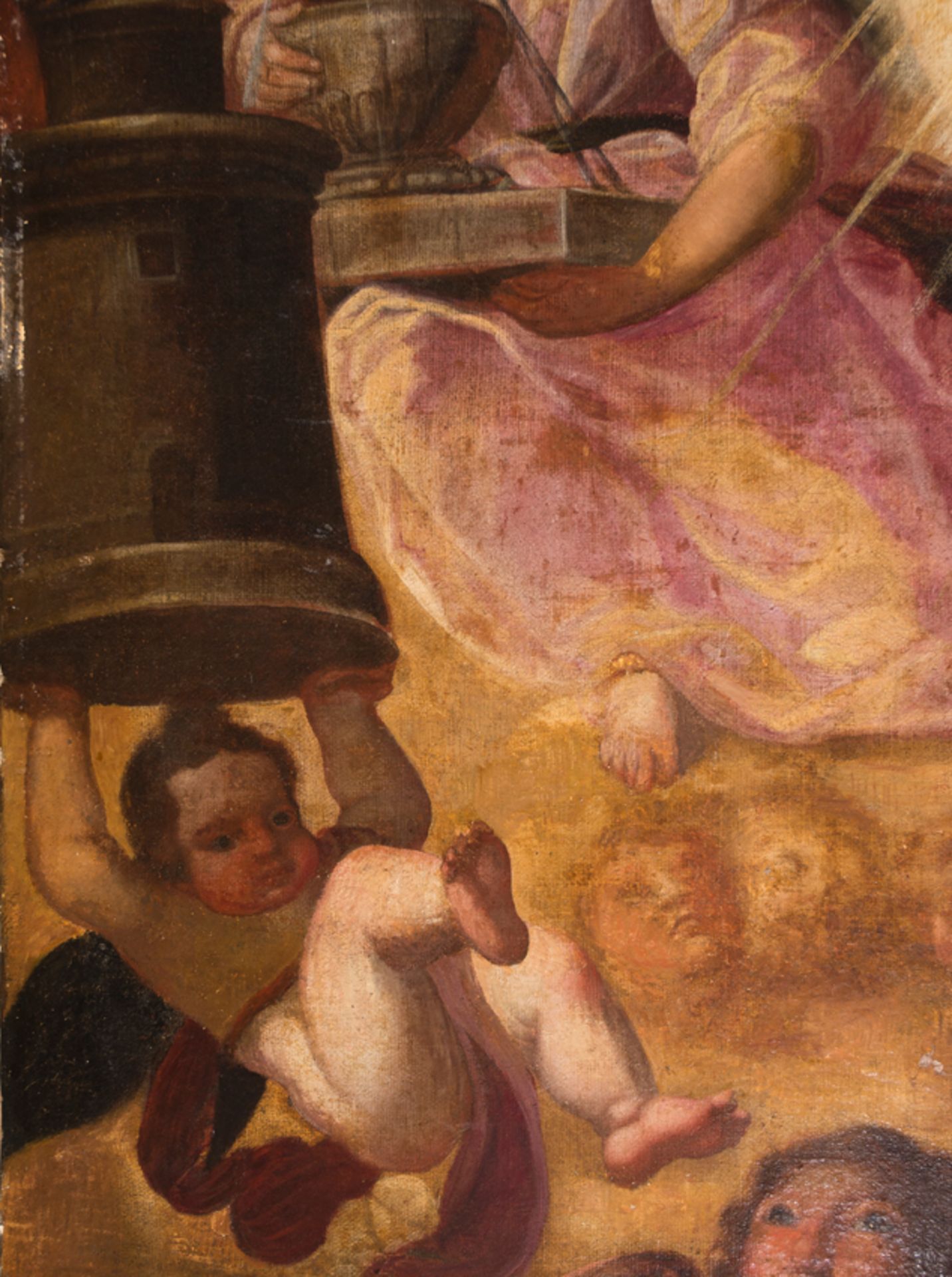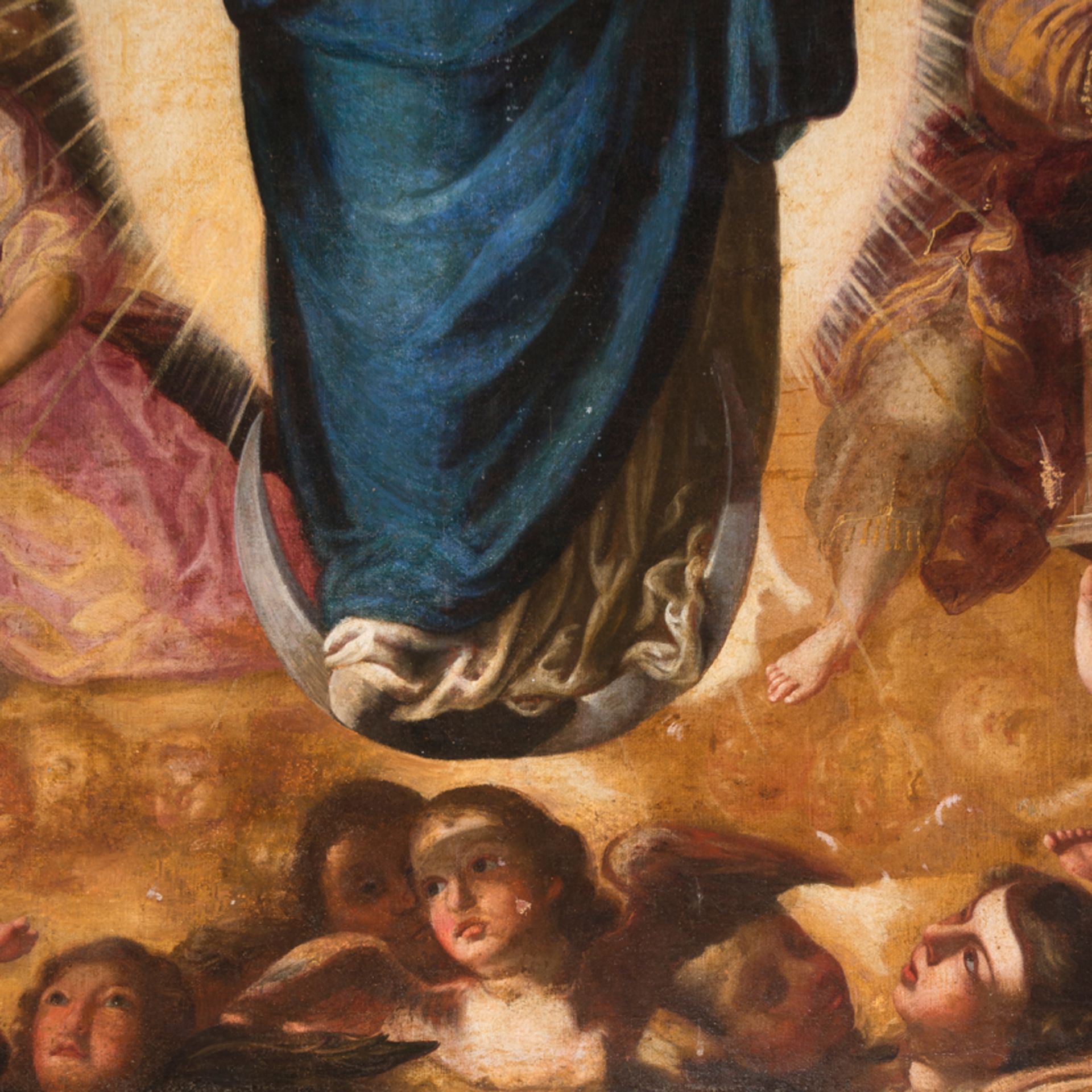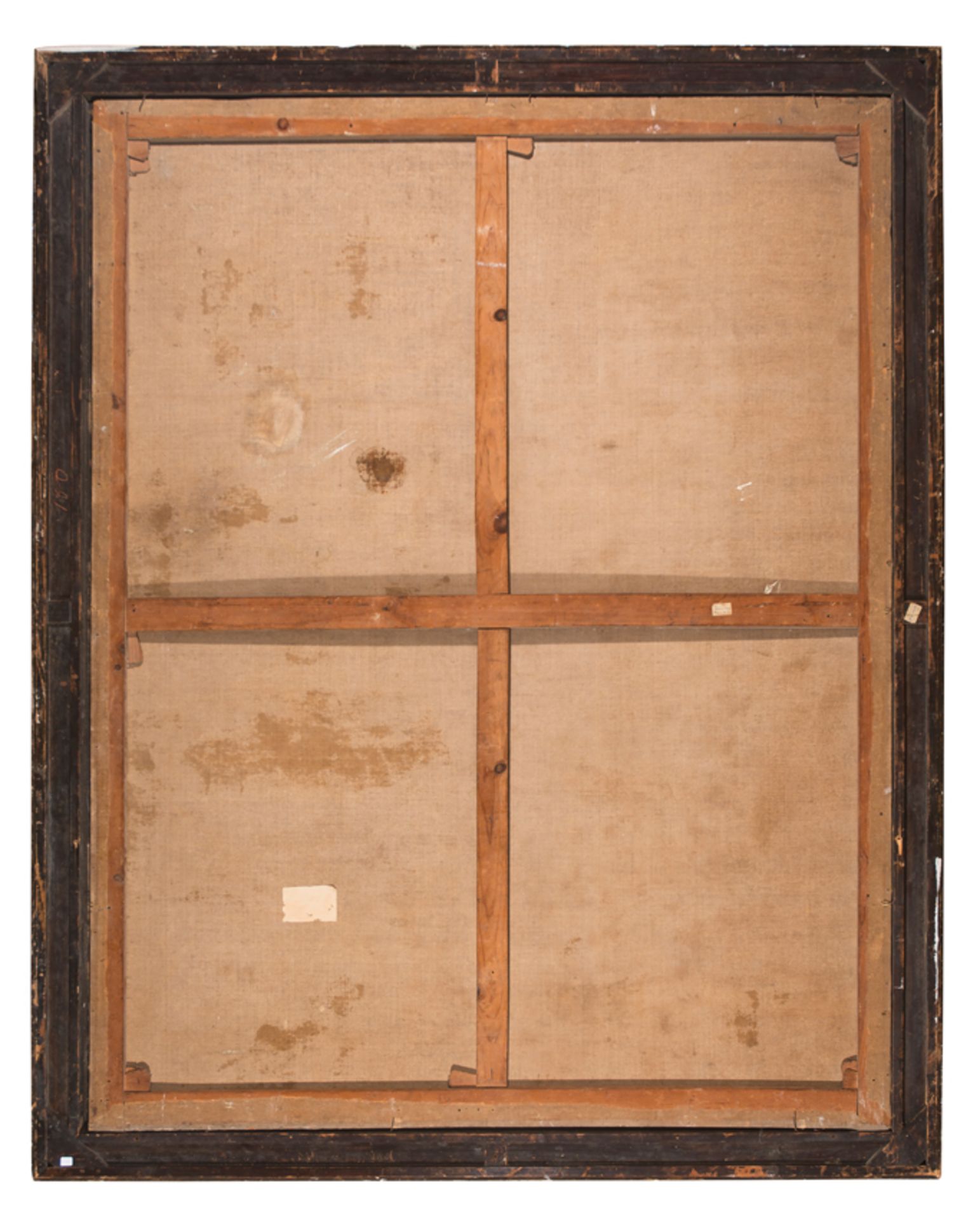54
Castilian or Madrid School. Second half of the 17th century.
"Our Lady Immaculate"
Oil on canvas. Relined. 207,5 x 160 cm.
The emergence of the iconography of Our Lady Immaculate in Spain has two big milestones: the years 1622 and 1661. In the first of these, and specifically on the 3rd November 1622, Pope Gregory V awarded Seville a papal brief, thanks to which the worship of the Immaculate Conception was permitted, which meant the virtual establishment of the dogma of the Immaculate Conception. On the 8th December 1661, Pope Alexander VI definitively promulgated the dogma, being influenced by King Philip IV, who knew the fervour his subjects professed for Our Lady Immaculate.
The painting that concerns us, which is full and detailed, meaning it was painted closer to the second of these dates, shows us a fully baroque exaltation in which the Virgin Mary, despite the calmness of her figure, is surrounded by a whirlwind composed of an infinity of angels of diverse classes and forms, some of them are daringly foreshortened or posturing. The small angels in the upper part, with chubby bodies only covered by a cloth hiding their private parts, bring her a crown and sceptre, accrediting her as the Queen of Heaven. Lower down is a series of adult angels as well as other more child-like ones at the bottom part who hold seven emblems of the Litany of the Blessed Virgin Mary: the Tower of David (Turris Davis cum propugnaculis, “Tower of David with bastions”), a fountain (Fons ortorum, “Fountain of orchards”), an olive branch (Oliva spcesiosa, “pleasing olive”) which perhaps refers to the Virga Jesse floruit (“Flowering of the stump of Jesse), a temple (Templum Dei, “Temple of God”), a well (Puteus aquarum viventium, “Well of living water”), and two trees: the palm and the cypress, both of which allude to triumph, victory and chastity.
The painting is outstanding due to its pictorial quality and the beauty of its different components, especially the Virgin Mary, which follows the iconographical norms dictated by the painter and treatise writer Francisco Pacheco (1564-1644). According to Velázquez’s father-in-law, the Virgin Mary should be depicted as a very young woman with a serene attitude and wearing a white tunic, cinched with a violet band and an ample blue cloak – these colours symbolise purity and eternity – which, making a turn at the front, is gathered between her arms and the edge of it falls over the left arm.
This curious depiction of Our Lady Immaculate, in an extremely lengthened canon with great elegance, is richly chromatic and has very rich contrasts in light, increased by the powerful, oval beam of light which is at her back. The Virgin Mary takes an oval shape, widened in the middle by her clothing – in the centre of the composition, symmetrical in spite of the perceived dynamism, she stands on a half-moon with the points facing upwards (crescent moon) which alludes to the Woman of the Apocalypse, to which the twelve-starred crown placed on her head also refers. The head, leaning and looking downwards, mixing humility and elegance, has delicate and youthful facial features, with rosy cheeks, a straight nose and an ample mane of hair which the wind blows around her back. Her hands are in prayer, with long and elegant fingers. Her silhouette stands out against a gilded background in which the aforementioned oval light at her back stands out and appears to emanate from her body itself, showing us a completely supernatural and mystical vision.
We do not know who painted this picture or where it came from, but it is most certainly the work of a skillful Castilian or Madrid-based painter who was working in the second half of the 17th century.
We would like to thank Javier Baladrón, doctor in History of Art, for cataloguing this piece.
"Our Lady Immaculate"
Oil on canvas. Relined. 207,5 x 160 cm.
The emergence of the iconography of Our Lady Immaculate in Spain has two big milestones: the years 1622 and 1661. In the first of these, and specifically on the 3rd November 1622, Pope Gregory V awarded Seville a papal brief, thanks to which the worship of the Immaculate Conception was permitted, which meant the virtual establishment of the dogma of the Immaculate Conception. On the 8th December 1661, Pope Alexander VI definitively promulgated the dogma, being influenced by King Philip IV, who knew the fervour his subjects professed for Our Lady Immaculate.
The painting that concerns us, which is full and detailed, meaning it was painted closer to the second of these dates, shows us a fully baroque exaltation in which the Virgin Mary, despite the calmness of her figure, is surrounded by a whirlwind composed of an infinity of angels of diverse classes and forms, some of them are daringly foreshortened or posturing. The small angels in the upper part, with chubby bodies only covered by a cloth hiding their private parts, bring her a crown and sceptre, accrediting her as the Queen of Heaven. Lower down is a series of adult angels as well as other more child-like ones at the bottom part who hold seven emblems of the Litany of the Blessed Virgin Mary: the Tower of David (Turris Davis cum propugnaculis, “Tower of David with bastions”), a fountain (Fons ortorum, “Fountain of orchards”), an olive branch (Oliva spcesiosa, “pleasing olive”) which perhaps refers to the Virga Jesse floruit (“Flowering of the stump of Jesse), a temple (Templum Dei, “Temple of God”), a well (Puteus aquarum viventium, “Well of living water”), and two trees: the palm and the cypress, both of which allude to triumph, victory and chastity.
The painting is outstanding due to its pictorial quality and the beauty of its different components, especially the Virgin Mary, which follows the iconographical norms dictated by the painter and treatise writer Francisco Pacheco (1564-1644). According to Velázquez’s father-in-law, the Virgin Mary should be depicted as a very young woman with a serene attitude and wearing a white tunic, cinched with a violet band and an ample blue cloak – these colours symbolise purity and eternity – which, making a turn at the front, is gathered between her arms and the edge of it falls over the left arm.
This curious depiction of Our Lady Immaculate, in an extremely lengthened canon with great elegance, is richly chromatic and has very rich contrasts in light, increased by the powerful, oval beam of light which is at her back. The Virgin Mary takes an oval shape, widened in the middle by her clothing – in the centre of the composition, symmetrical in spite of the perceived dynamism, she stands on a half-moon with the points facing upwards (crescent moon) which alludes to the Woman of the Apocalypse, to which the twelve-starred crown placed on her head also refers. The head, leaning and looking downwards, mixing humility and elegance, has delicate and youthful facial features, with rosy cheeks, a straight nose and an ample mane of hair which the wind blows around her back. Her hands are in prayer, with long and elegant fingers. Her silhouette stands out against a gilded background in which the aforementioned oval light at her back stands out and appears to emanate from her body itself, showing us a completely supernatural and mystical vision.
We do not know who painted this picture or where it came from, but it is most certainly the work of a skillful Castilian or Madrid-based painter who was working in the second half of the 17th century.
We would like to thank Javier Baladrón, doctor in History of Art, for cataloguing this piece.
Images. The Divine and the Human
Auktionsdatum
Ort der Versteigerung
Generelle Versandinformationen vom Auktionshaus verfügbar
The purchase price includes the delivery of the lots in the venue of the auction. Transporting to other destinations is at the own risk of the client. The customer must contact "LST", to give the corresponding instructions for such transporting. "LST" is not responsible for the packaging or any accident incurred during transportation.
Wichtige Informationen
Aufgeld / Premium: 22 %
Live: 3 %
jeweils zusätzlich USt. / both plus VAT: 21 %
AGB
CONDITIONS OF THE AUCTION:
I. REGISTRATION. To bid in the room customers must register at the beginning, filling out a form and picking a number that will identify them during the auction. Customers may be required to register in bank references or other guarantee system and if they do not prove the solvency "LST" will not accept bids and award the auction.
II. WRITTEN BIDS. "LST" will accept written bids, which will be formalized in the form provided by the room until the day before the auction. In such auctions, the room will bid in name of the client until the maximum stated in the offer and always at the lowest possible price. If there are two or more bids for the same amount, the one placed first will have the priority. Written bids received in advance, will have priority on the day of the auction.
III. TELEPHONE BIDS. "LST" will allow telephone bids, if interested people contact "LST" days before the auction providing personal data, ID card and the phone number which will be used by the staff of "LST" to call at the time of the auction. The buyer, within all the legal rights is making an offer for the asking price, when applies for telephone bid. "LST" will not take responsibility for any technical defects beyond its control, which may prevent to contact successfully the bidder during the auction.
IV. AUCTIONEER. The auction will be conducted by an auctioneer, director of the auction will be judge and arbitrator of it with full authority in its development, will award the lots to the highest bidder and is able to settle any controversy concerning lots sale, reject bids, divide lots or group them and remover objects from the room. Will be able to, if it is deemed suitable, not accept bids on the auction. His decision will be unappealable.
V. SALE OF LOTS. The lots are awarded to the highest bidder. Once the auctioneer blows the hammer, the buyer becomes responsible of the lot purchased, exempting "LST" of liability to for any damage and / or accidents that may occur. No refunds of lots.
VI. STARTING PRICE. The amount shown in the catalogue as the starting price for each lot will be, as a rule, the minimum selling price, except for exceptional cases where a reservation may be agreed upon with the seller or it set discretionary by the room.
VII. SCALE OF BIDS. The bids are set according to the following scale:
From 50.-€ to 200.-€…………………………………………..at 10.-€
From 200.-€ to 500.-€…………………………………… …25 in 25.-€
From 500.-€ to 1.000.-€………………………………..…..….50 in 50.-€
From 1.000.-€ to 2.000.-€………………………………..…100 in 100.-€
From 2.000.-€ to 5.000.-€……………………………….….250 in 250.-€
From 5.000.-€ to 10.000.-€…………………………………500 in 500.-€
From 10.000.-€ to 20.000.-€……………………………1.000 in 1.000.-€
From 20.000.-€ to 50.000.-€……………………………2.500 in 2.500.-€
From 50.000.-€ to 100.000.-€…………………………..5.000 in 5.000.-€
From 100.000.-€ to 100.000.-€………………………10.000 in 10.000.-€
From 200.000.-€ to 200.000.-€………………………25.000 in 25.000.-€
From 500.000.-€ to 500.000.-€………………………50.000 in 50.000.-€
VIII. RIGHT OF ADMISION. "LST" reserves the right to admission to the auction room and to reject, at its judgment, any purchase order, from clients whose solvency is not duly proved as well as not to sale auctions.
IX. SALE PRICES. The successful bidder of one or more lots must pay "LST" the final sale price achieves at auction, plus the 22 % plus 21% VAT on the commission, at total 26,62 % on Hammer Price.
X. CATALOG DATA. The catalogue data are obtained in order to careful research and advice, however, any responsibility is afforded about its accuracy. The lots will be auctioned in the state in which they are, not accepting any claims in restorations, breakage, damage, imperfections and, even description or numbering mistakes in the catalogue, in case of it, being the burden of the buyers to make sure before the auction that the description matches with their personal opinion about respective lot. The exhibition of the lots is intended to allow a perfect review and study of them.
XI. PAYMENT AND REMOVAL OF LOTS. Payment and removal of the lots will be held no later than five days following the auction. After this period expire without having the buyer removed the lot or lots purchases, it will accrue an expense of custody of 6 euros per day on each lot.
15 days after the auction without having the buyer paid and removes the sold lots, "LST" will inform the seller and there will begin judicial proceeding in order to obtain payment. The delay in payment by the purchaser of his/her sold lots will carry an interest increase at a rate of 1,5% per month.
XII. DELIVERY OF LOTS. The purchase price includes the delivery of the lots in the venue of the auction. Transporting to other destinations is at the own risk of the client. The customer must contact "LST", to give the corresponding instructions for such transporting. "LST" is not responsible for the packaging or any accident incurred during transportation.
XIII. RIGHT OF FIRT REFUSAL AND REPURCHASE. "LST" in order to article 38 of "Ley 16/1985 de 25 Junio del Patrimonio Histórico Español" (BOE. 155 June 29, 1985), will notify in advance to the Ministry of Culture, the content of their catalogues. Concerning the lots subject to the legislation referred to in the preceding paragraph, the Administration may exercise the rights of first refusal and repurchase according to the law. "LST" will watch over the protection of Artistic, Historical and Bibliographical Heritage of Spain. For customers out of European Community, a tax for export is required by the Administration.
XIV. VALUE ADDED TAX (I.V.A). This tax will be accrued on commissions of "LST" for buyers, using the rates prevailing on the date of the auction.
XV. DATA PROTECTION. In order to the "Ley 15/1999 de 13 de Diciembre, de Protección de Datos de Carácter Personal", the client authorize "LST", the inclusion of their data in a customer file, and for the promotion by "LST" of the objects at all times the rights of access, rectification or deletion of personal data by sending the appropriate request to the following address: LA SUITE SUBASTAS, C/ Conde Salvatierra, 8, 08006. Barcelona.
XVI. EXPRESS LEGAL JURISDICTION. These Conditions are governed by and interpreted in accordance with the rules of Spanish law. The mere act of participating in the auction as seller, buyer or bidder, implies acceptance of these Terms and Conditions.
Sales operations are understood to be held at the registered office of "LST", C/ Conde de Salvatierra, 8, 08006. Any dispute shall be taken to the competent courts of Barcelona, expressly waiving any other jurisdiction, in accordance with Article 55 of the "Ley de Enjuiciamiento Civil".






















